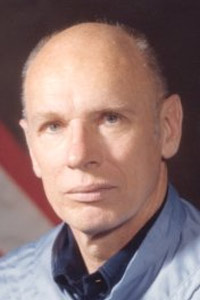Thank you very much for visiting Gunter's Space Page. I hope that this site is useful and informative for you.
If you appreciate the information provided on this site, please consider supporting my work by making a simple and secure donation via PayPal. Please help to run the website and keep everything free of charge. Thank you very much.
William Edgar ('Bill') Thornton

William Edgar ('Bill') Thornton
[NASA]
William Edgar ('Bill') Thornton (MD)
PERSONAL DATA:
Born in Faison, North Carolina, on 14 April 1929. Married to the former Elizabeth Jennifer Fowler of Hertfordshire, England. They have two sons.
EDUCATION:
Attended primary and secondary schools in Faison, North Carolina; received a bachelor of science degree in physics and a doctorate in medicine from the University of North Carolina in 1952 and 1963, respectively.
SPECIAL HONORS:
Recipient of the Air Force Legion of Merit (1956); the NASA Exceptional Service Medal (1972); the NASA Exceptional Scientific Achievement Medal (1974); the American Astronautical Society's Melbourne W. Boynton Award for 1975 (1977); two NASA Space Flight Medals (1983, 1985); the University of North Carolina Distinguished Alumni Award (1983); the Aerospace Medical Association Randy Lovelace Award (1984); the AIAA Jeffries Medical Research Award (1985); the Association of Military Surgeons of the United States Kern Award (1986); the NASA Exceptional Engineering Achievement Award (1988).
EXPERIENCE:
Following graduation from the University of North Carolina and having completed Air Force ROTC training, Thornton served as officer-in-charge of the Instrumentation Lab at the Flight Test Air Proving Ground. He later became a consultant to Air Proving Ground Command.
As chief engineer of the electronics division of the Del Mar Engineering Labs at Los Angeles from 1956 to 1959, he also organized and directed its Avionics Division. He returned to the University of North Carolina Medical School in 1959, graduated in 1963, and completed internship training in 1964 at the Wilford Hall USAF Hospital at Lackland Air Force Base, San Antonio, Texas.
Dr. Thornton returned to active duty with the United States Air Force and was then assigned to the USAF Aerospace Medical Division, Brooks Air Force Base, San Antonio, where he completed the Primary Flight Surgeon's training in 1964. It was during his two-year tour of duty there that he became involved in space medicine research and subsequently applied and was selected for astronaut training. Dr. Thornton developed and designed the first mass measuring devices for space, which remain in use today.
Dr. Thornton has logged over 2,500 hours pilot flying time in jet aircraft, is currently a Clinical Assistant Professor in the Department of Medicine, University of Texas Medical Branch, Galveston, Texas, and is an adjunct Professor at University of Houston, Clear Lake.
NASA EXPERIENCE:
Dr. Thornton was selected as a scientist-astronaut by NASA in August 1967. He completed the required flight training at Reese Air Force Base, Texas. Dr. Thornton was physician crew member on the highly successful Skylab Medical Experiments Altitude Test (SMEAT) -- a 56-day simulation of a Skylab mission enabling crewmen to collect medical experiments baseline data and evaluate equipment, operations, and procedures. Dr. Thornton was also the mission specialist on SMD III, a simulation of a Spacelab life sciences mission.
Dr. Thornton was a member of the astronaut support crew for the Skylab 2, 3, and 4 missions, and principal investigator for Skylab experiments on mass measurement, anthropometric measurements, hemodynamics, and human fluid shifts and physical conditioning. He first documented the shift and loss of fluid changes in body posture size and shape, including increase in height and the rapid loss of muscle strength and mass in space flight.
As a member of the Astronaut Office Operations Missions Development group, Dr. Thornton was responsible for developing crew procedures and techniques for deployable payloads, and for maintenance of crew conditions in flight. He developed advanced techniques for, and made studies in, kinesiology and kinesimetry related to space operations.
During Space Shuttle operations he continued physiological investigations in the cardiovascular and musculoskeletal and neurological areas. He developed the Shuttle treadmill for in-flight exercise and several other on-board devices. His work concentrated on the space adaptation syndrome, with relevant investigations on STS-4, STS-5, STS-6, STS-7, and STS-8.
Dr. Thornton holds more than 35 issued patents that range from military weapons systems through the first real-time EKG computer analysis. Space-related items include the first in-flight mass measurement devices, shock and vibration isolation systems, an improved waste collection system, an improved lower body negative pressure (LBNP) apparatus, and others.
A veteran of two space flights, Dr. Thornton has logged over 313 hours in space. He served as a mission specialist on STS-8 in 1983, and STS-51B in 1985.
Dr. Thornton continued his work in space medicine while awaiting his next flight opportunity. He worked on problems relative to extending mission durations in the Space Shuttle, in Space Station, and in space exploration, and has designed the necessary exercise and other hardware to support such missions. He continued analysis and publication of results from studies of neurological adaptation, and the study of neuromuscular inhibition following flight, osteoporosis in space and on Earth, and postflight orthostasis. He has completed designs for exercise and other countermeasure equipment for the Extended Duration Orbiter (EDO), and for Space Station Freedom, including improved treadmills, rowing machines, isotonic exercise devices, and a bicycle. Much of this is currently scheduled for flight.
Dr. Thornton retired from NASA effective 31 May 1994.
| # | Mission | Function | Launch | Landing | Duration | Remarks: |
|---|---|---|---|---|---|---|
| 1 | STS-8 | Mission Specialist | 30.08.1983 | 05.09.1983 | 0006:01:08:43 | |
| 2 | STS-17 (STS-51B) | Mission Specialist | 29.04.1985 | 06.05.1985 | 0007:00:08:45 | |
| Total: | 0013:01:17:28 | |||||
